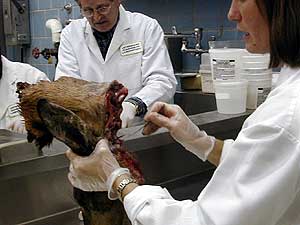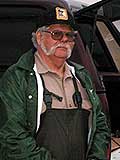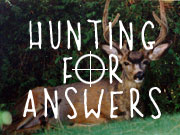Hunting for answers to the CWD mystery
November 18, 2002
 |
| Veterinarian Laurel Bjornson of Hayfield works to remove the brain stem of her deer sample. Bjornson participated in a training session at the U of M before the hunting season. (MPR Photo/Erin Galbally) |
Rochester, Minn. — Weeks before the first shots rang out in this year's hunting season, the University of Minnesota's Veterinary Diagnostic Lab was buzzing. Dozens of vets, technicians and students spent a Saturday learning how to look for chronic wasting disease. Dr. Will Hueston helped organize the day's events. He's director of the Center for Animal and Food Safety at the University.
Hueston slipped a pair of clear plastic boots over his dress pants, and prepared to wade through a chemical pool and into the lab.
"This is a disinfectant -- this is a diagnostic laboratory, meaning sick animals come here -- could be a whole range of things like salmonella. So we're very concerned not to track diseases out of the lab," says Hueston.
Inside it looks like the set from a horror movie. There is blood everywhere. Students in today's class bend over deer, elk and sheep heads. They cut, poke and prod the underside of the skulls. Some use a specially narrowed teaspoon, while others rely on scissors. They're all trying to find and dislodge the part of the brain needed to test for chronic wasting disease.
 | |||
"We call it the brain stem. That's at the very back of the head, the very base of the head. So they're learning to identify that area," says Hueston.
Virtually everyone in this class will perform similar dissections dozens, if not hundreds of times, over the course of this year's deer season. Some will assist the Department of Natural Resources in its attempt to gather up to 6,000 brain samples. Still others will work at one of 98 veterinary clinics across the state that will help hunters submit test samples for a fee.
Laurel Bjornson is a vet from Hayfield. Using a scissors, Bjornson pries out a deer's brain stem. It's white and chalky in her glove-covered hand.
"It feels like Malt-o-Meal. This one's frozen and thawed. I can't even identify it. It's nasty," says Bjornson.
The state has invested the bulk of its $500,000 in CWD funds in what it calls surveillance. That's come to mean testing a mass amount of animals in a short amount of time. Minnesota's focus is on identification of the disease, while out west, in Colorado and Wyoming where the disease has been prevalent since the late 1960s, there's greater emphasis on understanding how it's transmitted.
 | |||
Glen Zebarth has been working on CWD issues for more than two decades. He's a veterinarian and an elk farmer from Brandon, in west central Minnesota. Sandwiched between two students, he helps identify a brain stem.
"We piece those two together and we probably have the obex right here. It's the area that's critical to sample, the area where the vegas nerve comes in there," says Zebarth. "That's always the first spot the disease shows up in the brain, consistently it's been proven."
The vegas nerve extends from the stomach to the brain. And Zebarth believes one day it may be shown the disease is transferred from animal to animal through some form of ingestion - maybe food, water or saliva.
But after years of research, nothing has been conclusively determined. That's largely because the family of diseases that chronic wasting disease falls under continues to baffle scientists in virtually all of its forms.
The disease falls under the umbrella of transmissible spongiform encephalopathies. All involve a protein in the brain that's gone awry. Instead of lying flat, the protein known as a prion twists and bunches in clusters. Eventually, this results in spongy swiss cheese-like holes in the brain. In humans, the disease is known as Creutzfeldt-Jakob disease, and in cattle it's bovine spongiform encephalopathy or BSE. On the street it's called mad cow disease.
 | |||
Greg Poland is a professor of medicine and the director of the Mayo Clinic's vaccine research group. Poland says these diseases have thrown medical experts for a loop.
"To imagine that till the late 20th century and the beginning of the 21st, we had no idea these diseases existed. It's a whole new paradigm," says Poland. "The idea that these proteins can be transmitted and divide and cause abnormalities of other existing normal proteins is totally different than anything we would have been taught in medical school."
The United Kingdom's BSE epidemic in the 1980s and '90s weighs heavily on the minds of scientists like Poland. Scientists believe 130 humans have died so far from Creutzfeldt-Jakob Disease which developed after eating infected beef. And many like Poland wonder if eating sick venison could produce the same result.
"What gives us pause, and a lot of concern, is that in a test tube you can force this disease to become imbedded in human brain cells," says Poland. "Does it mean it will occur under natural circumstances? That's the great mystery right now."
Poland says he plans to hunt this year. He'll eat the venison, but he won't give it to his children. It's a case of what he refers to as biologic roulette.
 | |||
The Minnesota Department of Natural Resources has advised this year's hunters to take precautions. They include not eating the animal's brain, spinal cord, or lymph nodes; avoiding deer that appear malnourished, sickly or exhibit strange behavior. And for those who want further reassurance, it's possible to have deer tested for CWD.
In southeastern Minnesota, a free testing program sponsored by the DNR got off to a slow start.
The agency's Tony Stegen spent the first day of hunting season in a Plainview parking lot, waiting for hunters. Stegen's job was to remove the deer head and then send it to a lab for testing.
"We cut it right off about four inches in the back of the head. We twist the head off the vertebrae and we bag it," says Stegen.
After nine hours of sitting around, Stegen had only collected one head. The DNR needs him to get 36. On day two, business picked up a bit. Six heads were sent on for testing. But those low numbers aren't a reflection of hunter turnout. Permit sales were 12 percent ahead of last year on the first day of the November hunt, and there are predictions turnout this year could set records.
That's good news for the Department of Natural Resources, but no one denies that hunting in Minnesota has been markedly changed. From now on, deer hunting and chronic wasting disease are inextricably intertwined. And according to most wildlife officials, it's not a question of if the disease is found in Minnesota's deer population, but when.
|
News Headlines
|
Related Subjects
|

